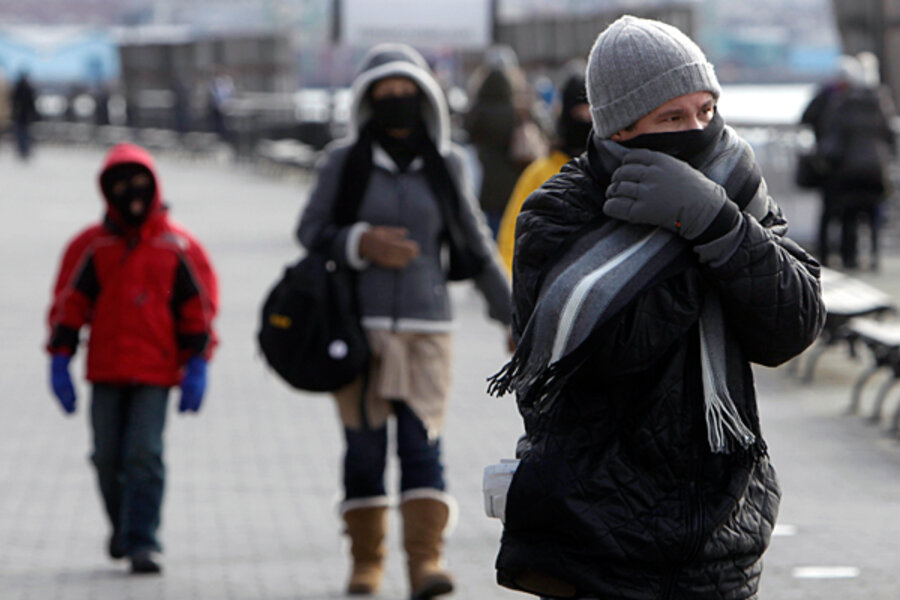The scold in Mother Nature's cold: It's winter! Wear a coat!
Loading...
| New York
Mother Nature poured bitter Arctic temperatures into the eastern third of the nation Wednesday, reminding people from Maine to Florida that they’ll need their parkas this winter after all.
According to Accu-Weather.com, temperatures ranged from minus 17 degrees in Saranac Lake, N.Y., to 13 degrees in New York City to 32 degrees in Disneyland. The cold snap stretched as far south as Miami, where residents awoke to 43-degree temperatures.
Aside from lots of people needing to bundle up, though, it appears the East’s first brush with ice-box-like temperatures has not caused any major problems.
So far, it appears the fruit and vegetable crops in Florida have come through without any major damage that might cause food prices to soar, as happened following two damaging cold snaps in December of 2010. And, even though many people have had to crank up their thermostats, the heating-oil industry says there does not appear to be any supply-related hiccups.
[ Video is no longer available. ]
“The reason this is getting attention is because it’s been so mild so far this winter,” says Dale Mohler, a meteorologist at Accu-Weather.com in State College, Pa. “If this were a normal winter, you wouldn’t be thinking twice about this.”
In fact, Mr. Mohler says, there is no need to cancel the trip to Florida because the cold weather is expected to dissipate in the next day or two. By Thursday afternoon, visitors to Disneyland will be walking around in T-shirts, and by Friday it could be back to 80 degrees in Miami.
“This cold weather is just a brief interlude,” he says, noting that even in New York the thermometer will read 50 degrees by the weekend.
The sub-freezing temperatures in Florida apparently did not do much damage to the nation’s winter vegetable crop or the citrus groves. According to Lisa Lochridge, a spokeswoman for the Florida Fruit & Vegetable Association in Maitland, there was only “patchy” damage from frost. She says a few temperature-sensitive varieties, such as snap beans, appear to have been damaged. But, the tomato, strawberry, and citrus crops seem to have survived.
“By this time last year we had already had two significant freezes from December,” she says. To top it off, cold weather extended into Mexico, damaging the vegetable crop there. In Yuma, Ariz., the lettuce crop was badly damaged by two successive days of temperatures below 20 degrees. By the spring, vegetable prices had risen by 50 percent and food prices as a whole had risen at their fastest pace since 1974.
The heating-oil industry says the cold snap is not affecting supply either. The temperature has not been cold enough to freeze up the rivers that are used to transport the heavy oil to inland areas. In addition, consumers have been steadily switching from heating oil to natural gas, which has been a lot more stable in price.
Even more importantly, consumers are doing their best to control their fuel usage.
“Over the last nine years, the average customer is using 30 percent less fuel,” says John Huber, the president of the National Oilheat Research Alliance in Alexandria, Va. “They are doing it through better insulation, better [oil] burners, and turning down the thermostat,” says Mr. Huber. “Seven to eight years ago, the average household consumed 800 to 900 gallons of fuel in a winter; now, they consume 600 to 700 gallons per household.”
Unfortunately for heating-oil consumers, the price of fuel has been rising because the price of crude oil has been high all fall and early winter amid tensions in the Middle East. Last week, President Obama signed a law that makes it harder for companies to deal with the Iranian Central Bank. On Monday, Iran talked about closing down the Straits of Hormuz. This bumped the price of oil up 4 percent for the day.
“With all this talk about going to war in the Middle East, it gives the speculators one more reason to pump up the prices,” says Mr. Huber.
According to the Energy Information Administration, the average price in the US is $3.83 a gallon, a record price. This time last year, the price was $3.31 a gallon.
The cold weather may also limit the amount of time the Republican candidates in New Hampshire spend outdoors. On Wednesday, Lebanon, N.H., a stopping off point for many candidates, was in the teens.
“The candidates are going to need some heavy duty winter garb,” says Mohler. “But, by this weekend they will be taking it off because the temperatures will be in the 40s.”
Once the Eastern third of the nation warms up, it won’t get cold again until later next week, says Mohler. “It does look like next week is going to be more normal,” he predicts.
After that it seems the month may turn colder and maybe even snowier. “If you are a snow lover or skier it looks like there are some better days ahead,” he predicts.







